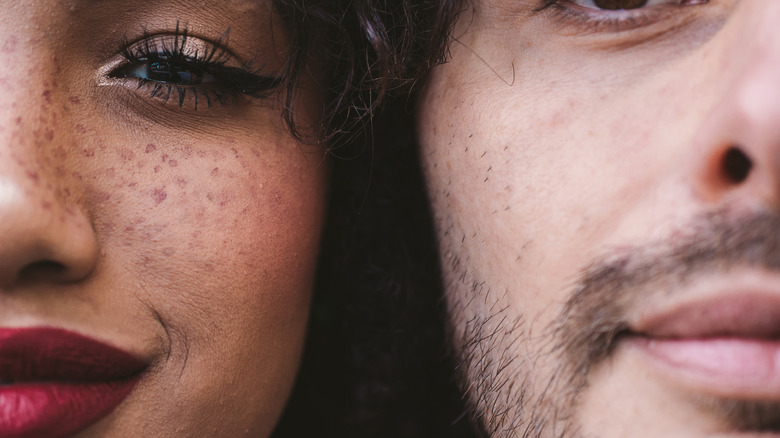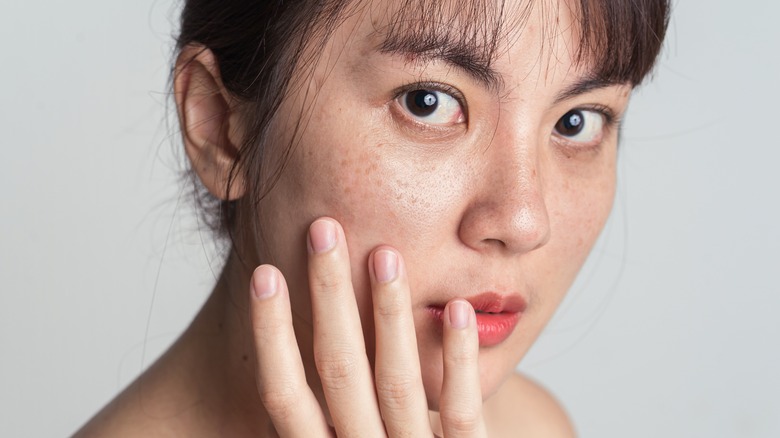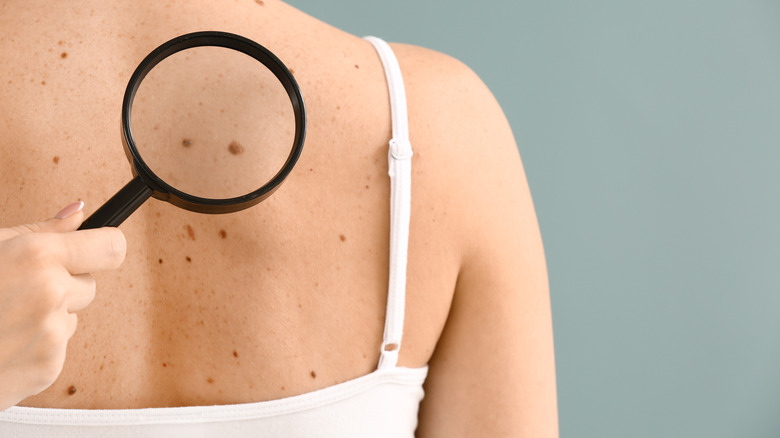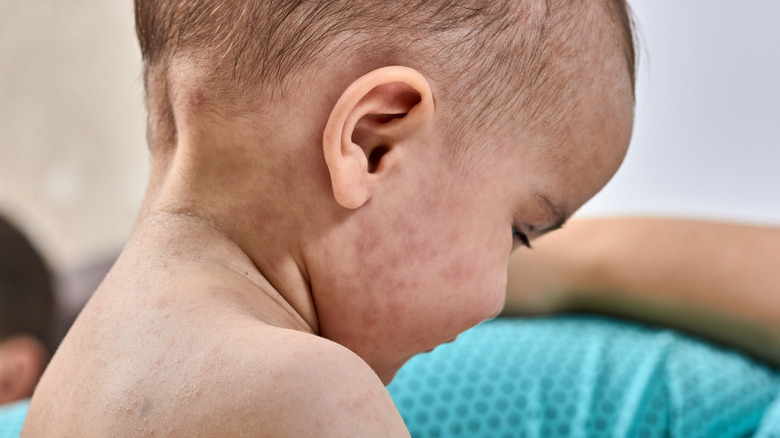All Freckles Aren't The Same. Here's Why
As summer nears, you may begin to notice a crop of freckles appear on your skin after you've spent an afternoon enjoying the warmer temperatures outside. These could be freckles that you've had since early childhood that become darker after exposure to ultraviolet (UV) rays, or they could be freckles you're noticing for the first time. You may realize that you have more freckles after spending time in the sun, or that your freckles fade at certain times of the year. You may also find new freckles developing as you enter mid-adulthood.
Freckles are made of melanin, a naturally occurring substance in the skin that creates your skin's pigment, reports Healthline. When your body creates an overproduction of melanin, freckles form. Overproduction of melanin can be stimulated by UV rays, which is why freckles are often associated with a sun-kissed aesthetic (though always remember to wear sunscreen!)
Everyone has a different amount of melanin, which is based on genetics, lifestyle, and other aspects unique to each person, according to Medical News Today. The appearance of freckles can be just as individualized, from their size and shape to their occurrence and composition. Variations in the types of freckles you may have depends on your genes, age, exposure to sunlight and UV rays, and many more factors. Not all freckles are the same, and here is why.
Natural freckles
There are two types of freckles that develop naturally: ephelides and solar lentigines (via WebMD). The type of freckles you have on your body depends on several factors. Some freckles come from your genetic makeup, while others appear because of exposure to sunlight.
Ephelides are freckles that appear in early childhood, usually around the age of 2 or 3 years old, per WebMD. They vary in color but are usually shades of brown or red. Ephelides are usually only one to two millimeters but can sometimes be larger, and they often have irregular borders. Because they are emphasized by sun exposure, ephelides can become more prominent during warmer months when people typically spend more time outside, and they can fade during colder months when being indoors tends to be favored.
Solar lentigines, on the other hand, are freckles that show up as you age, according to WebMD. While ephelides appear during childhood and can fade as a person enters adulthood, solar lentigines tend to appear after 50. Terms you may have heard, like sunspots, liver spots, and age spots, all refer to solar lentigines. While ephelides are often found on the face, solar lentigines can appear anywhere on the body that receives sun exposure (per Mayo Clinic). Solar lentigines vary in color from dark brown to light yellow.
Cosmetic freckles
If you don't have natural freckles, there are ways to create artificial freckles. In fact, using eyeliner to dot on faux freckles has become a popular makeup trend, according to Byrdie.
Semi-permanent cosmetic freckles have also become popular, including freckle tattoos and henna freckles. Freckle tattoos are applied by cosmetic tattoo artists. The initial darkness right after your appointment will likely fade, but the result and can last years with regular upkeep, reports Byrdie.
Henna freckles also result in semi-permanent spots, but tend not to last as long as tattooed freckles, according to Allure. When pursuing henna freckles, it's important to choose the right kind of henna dye, especially when applying henna on your face. It's advised to stay away from dyes intended for hair and Black henna, which contains harmful additives (via Byrdie).
Using the wrong type of henna dye could cause harmful inflammation and skin reactions, per Byrdie. Do your research before pursuing henna freckles, seek out dyes made of natural ingredients, and look for a skilled henna artist in your local area instead of trying to apply henna dye by yourself.
Be certain to check the ingredients in your makeup products to ensure that they don't contain anything that could be harmful to your skin. Always consult with a dermatologist if you have any concerns about the products you are applying to your skin.
Freckles are different from moles
Due to similarities in appearance, freckles and moles can be easily mistaken for the other, though they are two separate skin conditions. According to Healthline, both moles and freckles are skin lesions, or marks on the skin, but there are several characteristics that make each type of skin mark distinct. Freckles are usually the result of sun exposure, and those with lighter-colored skin are more likely to develop them. Moles tend to be darker in color than freckles and can become malignant due to skin exposure. Moles form when there is a cluster of pigment-forming cells attached to blood vessels that grow together to create a spot of excessive coloration on the skin. Like freckles, a person can be born with moles, and they can also develop moles as they age.
Even though freckles can become visible following time spent in sunlight, there is an extremely slim chance of freckles becoming cancerous, and they generally don't pose any threat to a person's health (via MedicineNet). However, moles aren't always as harmless, so it's important to differentiate moles from freckles and to monitor the growth and development of any moles you may have. The Centers for Disease Control and Prevention (CDC) recommends following an alphabetical method for determining the risk an individual mole poses. Use the ABCDE method to determine A for asymmetry, B for irregular borders, C for multiple colors, D for diameter, and E for whether the mole is evolving. If you notice your moles changing, consult with a dermatologist.
Freckles can indicate rare diseases
Sometimes, freckles can be symptoms of underlying conditions. In particular, a type of freckling called axillary freckling can indicate a rare, tumor-causing disease (per MedicineNet). Axillary freckling is a side effect of neurofibromatosis, a rare genetic condition that can be inherited and create a substantial number of freckles in the axillary regions, which are located around the armpit areas. According to the National Library of Medicine, axillary freckles are caused by an increased presence of melanin, just like traditional freckles. Axillary freckles, however, are distinct in that they are made up of a cluster of small, dark freckles on armpit skin.
Neurofibromatosis diseases, otherwise known as neurofibromatoses, are a group of several inherited conditions that result in tumors growing on nerve tissue, per Mayo Clinic. The tumors involved in neurofibromatosis can form on any of the body's nerve tissue but are often detected in the spinal cord, brain, and various parts of the nervous system. Axillary freckles indicating a neurofibromatosis disease most often appear in childhood between the ages of 3 and 5. In addition to forming in the armpits, axillary freckles can sometimes form on groin skin as well.
While there are three different neurofibromatosis diseases, axillary freckling is most often associated with neurofibromatosis type one (NF1), which develops in childhood, while the other neurofibromatosis conditions develop later in adolescence and adulthood. If left untreated, neurofibromatoses can cause multiple health issues including hearing and vision loss, significant pain, learning impediments, and heart problems.
Differentiating freckles and café-au-lait spots
Like moles and other skin markings, café-au-lait spots are often mistaken for freckles, reports Healthline. Similar to axillary freckling, café-au-lait spots can indicate a neurofibromatosis disease. Many times, though, they are completely harmless and simply skin expressions that are frequently present at birth. Café-au-lait spots are often considered to be a form of birthmark similar in color to the tan and light brown shades of a café-au-lait beverage.
Just like freckles, café-au-lait spots are flat and may become darker with sun exposure, thus creating a mistaken identity between the two types of skin markings. Both freckles and café-au-lait spots can be developed throughout the lifespan, whether they are present at birth or not, and café-au-lait spots are further mistaken for freckles because they can be as small as half of a centimeter. The distinction between freckles and café-au-lait spots comes with the frequently irregular shapes and edges of café-au-lait markings. While a person will often have numerous freckles, typically only one to three café-au-lait spots are present on a person's body.
Cleveland Clinic recommends consulting a healthcare provider if more than six café-au-lait spots are present since the increased number can indicate neurofibromatosis type one (NF1). Café-au-lait spots are formed by excess production of melanin, just like freckles, and will often become darker in color after the age of 2. For the first two years of a child's life, café-au-lait spots may be present but too light in color to be easily visible.






